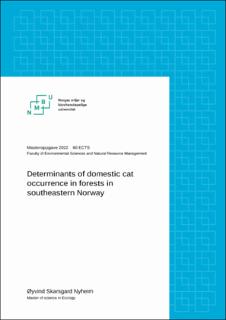Determinants of domestic cat ocurrence in forests in southeastern Norway
Master thesis
Permanent lenke
https://hdl.handle.net/11250/3012353Utgivelsesdato
2022Metadata
Vis full innførselSamlinger
- Master’s theses (MINA) [668]
Sammendrag
Domestic cats can pose a significant threat to local wildlife in urban and rural areas because of their high densities and proficiency as predators. However, few attempts have been made to quantify the impact of domestic cats on natural areas like forests, and even the extent to which cats use forests and areas further away from human influence remain uncertain.
I estimated cat occupancy at 411 forest locations in southeastern Norway from April 2018 to March 2021 using camera traps. I investigated how cat occupancy and detection probability was impacted by human infrastructure, habitat and the terrain. Subsequently, I used the best supported occupancy models to predict occupancy across forests in southeastern Norway.
Cat occupancy decreased strongly further away from houses, and cats if present were more likely to be detected closer to houses and forest edges. The best-supported models predicted that cats were present at 70% and 47% of forest sites 100 and 200m away from houses respectively, and cat presence only dropped below 10% more than 900m from residential houses. The model also predicted that cats were present in 12.5% (95% CI: 10-15%) of forests in southeastern Norway.
This study corroborates previous findings that cats are more likely to use natural areas near houses, but also show that cat activity may extend further away from houses into forests than previously thought. However, more information on cat abundance and hunting habits in forests is needed to assess the impacts cats have on forest fauna. This study represents the first population-level study on what determines where cats occur in a large forested area, while simultaneously accounting for habitat characteristics and imperfect detection.

